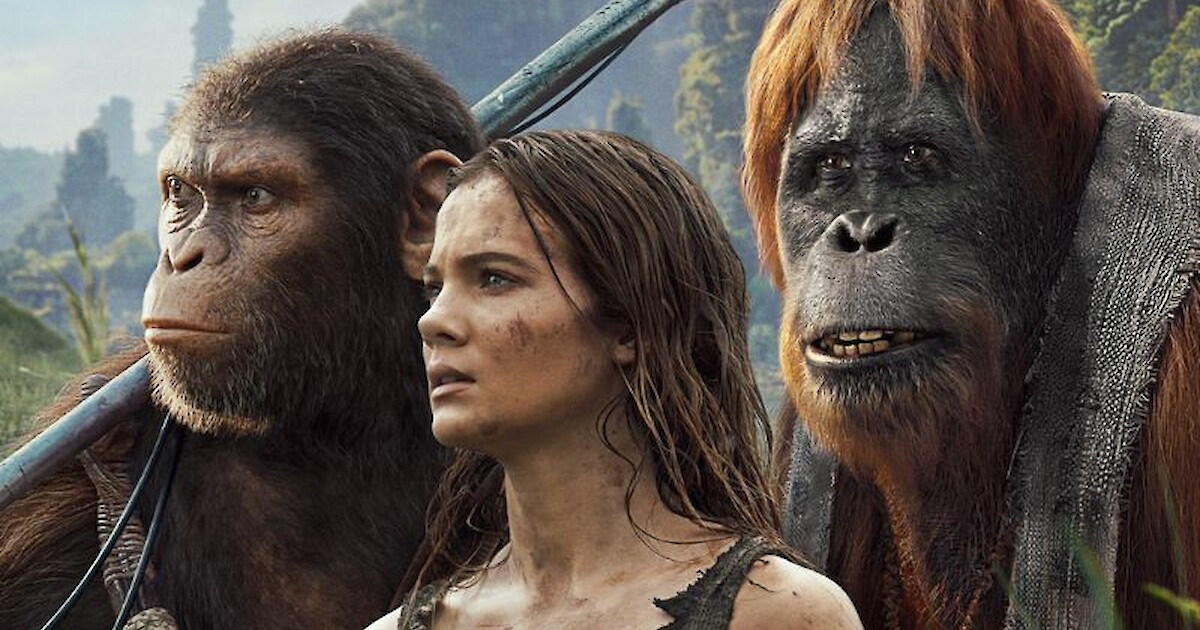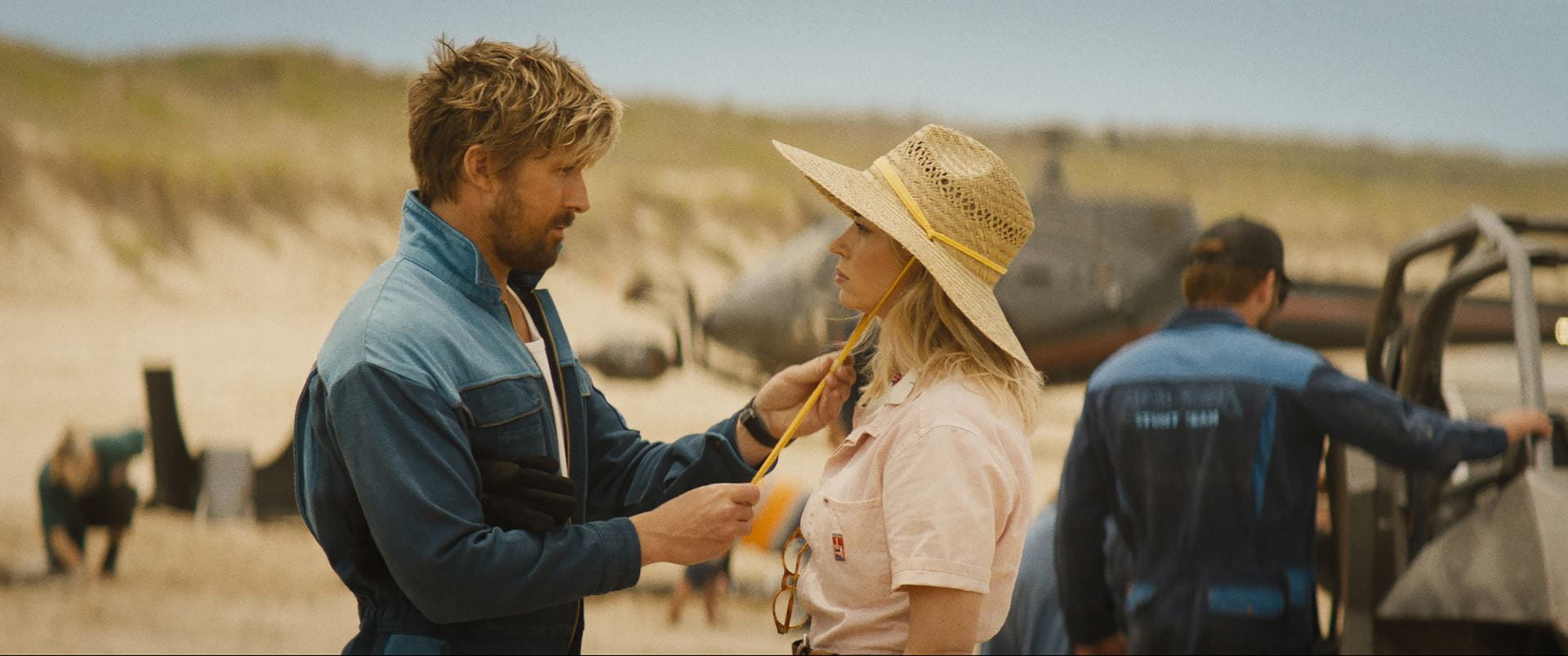Movie Reviews
Late Night with the Devil movie review: haunted by an AI specter – FlickFilosopher.com

I first saw Late Night with the Devil at London Film Festival last autumn, and it has been embedded in my brain ever since, like an itchy splinter. I thought: This is an astonishing movie: uniquely fresh and original while also deeply lodged in the history of cinematic horror, with a powerful breakout lead performance from long-time “oh, it’s that guy” David Dastmalchian, who has been, onscreen, the most delightful weirdo — perhaps most notably as “Polka-Dot Man” in 2021’s The Suicide Squad; he also has small roles in that year’s Dune and the recent Oppenheimer — and here exudes true movie-star quality.
I wish I had reviewed this five months ago, but I’ve been dealing with my own mental-health issues that aren’t a million miles away the crisis of confidence that Dastmalchian’s troubled protagonist is coping with here. I couldn’t manage it, so I was happy that the film had scored a theatrical release on both sides of the Atlantic, which meant another opportunity to review it. But it’s all been a bit soured by the recent news that the filmmakers — the writing-directing team of Australian brothers Cameron and Colin Cairnes — utilized “AI” “art” in their production design.
I suspect that the general public doesn’t yet understand how programs erroneously dubbed “AI” are being deployed and the capacity this has to inflict enormous damage in both visual and written creative arts. In brief, computer algorithms that are nowhere near artificially intelligent have been trained on the enormous quantities of written text and visual art (drawings, paintings, photos, etc) available online to spit out what are essentially remixes of that preexisting material. These “AI”s do this in response to human-generated “prompts,” such as, for instance, “image of a walkable city with lots of greenery and beautiful buildings” or “write a literary essay exploring the themes in George Orwell’s novels.” But resulting text meant to sound natural is often stilted and rife with factual errors and references, such as to supposed scientific papers or legal decisions, that are outright inventions. Visual results meant to look realistic are often full of bizarre nonsense, like human figures with too many limbs or fingers, or impossible angles or lighting.
If you’re Extremely Online, as I am, you’ve already come across numerous examples of human writers, voiceover performers, and visual artists complaining about losing paying jobs to “AI,” including so-called deepfake video technology. (One of the issues behind last year’s Screen Actors Guild and Writers Guide strikes was studio use of these “AI” algorithms to replace their members’ work.) Even though there is no authentic creative effort or considered thought behind the output of these programs — they are incapable of conceiving anything new — they are already substituting, if poorly, for human innovation and inventiveness.
This is where Late Night with the Devil utilizes “AI”-generated visuals:
The movie is mostly set over the course of a single episode, which we’re told went out live on Halloween night 1977, of a (fictional) American late-night talk show called Night Owls, which aired on the (fictional) network UBC. The seasonally appropriate show logo (in this still from the trailer; it appears regularly in the film) was created not by a human artist but by “AI”: the wonky windows on the skyline building are a dead giveaway.
Here’s another of the show’s interstitials, a title card welcoming viewers back from commercials:

Here the missing fingers on the skeleton clue us in to the fact that the image has been generated by “AI.”
Now, you might be thinking, “What’s the big deal? It’s just a couple of images in the background.” There are many reasons why this is a big deal, perhaps not least: 1) the actual creative work of actual human beings was stolen without permission or recompense and repurposed by a computer program to concoct these images, and 2) actual creative artists were therefore not paid to work on this film in this capacity. It’s bad enough when money-grubbing, artist-denigrating megacorporate Hollywood studios do this — it’s not forgivable, of course, but it’s certainly well within their vampire-capitalist wheelhouse — but it’s far worse when a scrappy little indie production like this one does it. If the fire of human weirdness and invention is not appreciated by a pair of maverick brother filmmakers like the Cairneses, working so far outside of Hollywood that they’re literally on the opposite side of the planet — Late Night was shot in Melbourne — then what hope is there for anyone who just wants to be an arty freakazoid eking out a little living with their ingenious eccentricity?
I don’t know the Cairneses’ previous work, but I don’t understand how you can have the kind of deliciously disturbed imagination that rustles up the bonkersly off-kilter Late Night with the Devil and not understand that legitimizing the theft of bona-fide human imagination is so uncool. (Here’s a good Twitter thread on why this is a big deal and why it’s important to send filmmakers and studios the message that this is Not Okay.)

Dedicated movie fans are engaging in personal boycotts of this movie over the “AI” issue, they feel that deeply that this is a huge problem, and I am very much on their side. I debated with myself whether I should even give the movie what small exposure a review from me would bring it. I decided it was worth it in order to highlight this issue for the vast majority of movie lovers who are not Extremely Online. Because letting mindless computer algorithms built on the hijacked work of creative human beings is going to be very very very bad for anyone who cares about the work of creative human beings, such as movies. We are at the narrowest edge of a horrible wedge, and the time to push back is now.
Here’s the incredibly ironic thing about Late Night with the Devil: it is, at its heart, a story about a creative man who is, as I mentioned earlier, suffering a crisis of creative confidence and also, most likely, creative burnout. Dastmalchian’s late-night TV host Jack Delroy, a former Chicago radio personality, just cannot seem to make enough of a dent in the popularity of his competition: ur–late night TV host Johnny Carson and his The Tonight Show. We learn this in the mockumentary opening of the film, which sets the stage for the 1977 Halloween broadcast: Delroy is a man who has been on a roller coaster of personal tragedy and professional success and intrigue all around: he’s a member of an arcane secret society — of, natch, white men — known to make or break careers. Delroy’s career isn’t quite broken, but it’s not as solid as it could be. Maybe there’s a way he can bolster himself and his show? Via, like, some arcane stuff? *gulp*

Oh, so, why burnout? In 1977, The Tonight Show ran for 261 episodes, one for basically every weeknight of the year. It’s a grueling schedule. Night Owls would have had a similar run. (Watching this movie at London Film Festival was a surreal experience for me, as a transatlantic type, for more reasons than the uncanny stuff happening onscreen, because there is no British equivalent of the American late-night-talk-show ecology; perhaps the closest thing in the 2020s is the solitary example of The Graham Norton Show, which airs only once a week, not nightly, and then only typically for half the year.) Late-night is a meatgrinder of American television. Like, no wonder someone might turn to the supernatural for an assist.
Wait, what?
The faux-documentary-style narrator informs us that we are about to be treated to the “recently discovered master tape of what went to air that night, as well as previously unseen behind-the-scenes footage.” It was, we are told, “the live-TV event that shocked the nation.”

What we witness in its ersatz-70s glory is late-night American TV at its cheesy apex. Guests for Delroy and his goofy punching-bag sidekick Gus (Rhys Auteri) include Uri Geller–esque psychic performer Christou (Fayssal Bazzi: Peter Rabbit), who does hilariously terrible (from our 2020s perspective) cold-readings on the studio audience; paranormal skeptic Carmichael Haig (Ian Bliss: The Matrix Revolutions), clearly modeled on James Randi, who throws cold water over Christou; and parapsychologist June Ross-Mitchell (Laura Gordon: Foe),who’s just written a book about her work with a teen Lilly D’Abo (Ingrid Torelli), a waif rescued from a “satanic cult” and allegedly in the grips of a “psychic infestation” — Ross-Mitchell prefers that term over “demonic possession.” It’s all so very late-70s: this was the era of Amityville Horror paranormal investigators Ed and Lorraine Warren, of The Omen and The Exorcist. This was the cultural stew from which the so-called satanic-panic bullshit of the 1980s would spring.
Now, the mockumentary conceit falls down in the behind-the-scenes stuff, which purports to show what is happening backstage at the Night Owls studio while the live feed goes to commercial break. But we never understand who is shooting this material, or why… and it certainly never makes sense that these people would be having the conversations that they’re having if there was a camera there recording them. I don’t mind that much, because a breakdown of the documentary style is necessary for the ambiguous ending to work… which it does.

I found it all a perfectly pitched nightmare of overegged ambition and an anything-for-success drive, and a sly twisting of the cosy familiarity of late-night TV, meant to soothe its viewers at home into sleep and not do, er, what this episode of Night Owls does. The entire cast is terrific, but this is Dastmalchian’s showcase, and he is marvelous: he nails the quirky but easy charisma late-night demands.
But the triumph of Late Night with the Devil is absolutely marred by the Cairneses own little deal with the AI devil. “It wasn’t supposed to turn out this way,” Jack moans as his Halloween episode goes to credits. It’s a shame that the same could be said about this film.
more films like this:
• The Last Exorcism [Prime US | Prime UK | Apple TV]
• What We Do in the Shadows [Prime US | Prime UK | Apple TV | BBC iPlayer UK | Shudder UK]

Movie Reviews
The Roundup Punishment Review: Sturdy Formula

The Roundup: Punishment is earnest and fun enough as a turn-your-brain-off action film, but its formula is its greatest flaw as it is its strength.
Director: Heo Myeong Haeng
Genre: Action, Crime
Run Time: 109′
US Release: May 3, 2024
UK Release: May 3, 2024
Where to watch: in theaters
Korean Title: City of Crime 4
English Title: The Roundup – Punishment
I don’t think I’ll ever comprehend how movie title translations work. Then again, I shouldn’t bash the English side only. I mean, the film Fate of the Furious is translated as Furious Ride: The Extreme in Korean.
Directed by Heo Myung-haeng, The Roundup: Punishment is the fourth installment in The Roundup series, following Ma Seok-do (Ma Dong-seok, of Train to Busan), and his battles against crime as the Seoul Police Agency lieutenant. This time, his battle is against an online gambling organization exploiting and even killing off teenagers. God help the criminals.
Maybe that was shorter than usual, but you need to understand that this goes for The Roundup series in general. They are not complicated movies. Ma Seok-do finds a group of irredeemable criminals, and his hulking mass of muscles and an even greater sense of justice leads him on an unstoppable rampage against crime. Lots of action, just as much comedic bits, and you have the series in a nutshell; The Roundup: Punishment is no exception.
It’s easy to understand if you look at Ma Dong-seok. His filmography mainly consists of him as a physically dominant action star that also doesn’t forget a bit of heart and a little adorableness on the way. In other words, he’s the Korean equivalent of Dwayne Johnson, Jason Statham, Liam Neeson, etc, where the actor has created a popular typecast image around himself, one that’s genuinely likeable and easy to consume. I don’t dislike these sort of actors. Yes, one could accuse them for basically playing the same character in every movie, but even creating that iconic typecast image takes genuine skill.
If Ma Dong-seok was really ctrl cv-ing his performances across his movies, then that image would have run dry very fast. Instead, while his general mannerisms and settings are similar, he brings in different bits of heart or dialogue to each of his roles, so that they are recognizable as the Ma Dong-seok brand, but still feels just different enough to watch. When this typecast imagemaking is done well, I can enjoy myself, and that certainly is the case with The Roundup: Punishment. Ma Dong-seok is a large part of what makes the film tick.

But if the movie puts in no effort beyond its star, then even a strong typecast image cannot carry the entire film on its own. Thankfully, The Roundup: Punishment isn’t one of those movies. For one, the film’s action is actually a lot stronger than I expected. Ever since John Wick (2014) popularized the “steady cam” style of action, so to speak, more movies have thankfully been following its example, and this is one of them. Camera remains fairly steady, and the shots are long and clean, giving the audience enough time to take in the stunt work.
In addition, the film doesn’t forget that Ma Dong-seok isn’t the only character in the film. Seok-do’s police comrades might not get deep or largely compelling stories, but they still remain likeable and relevant in bringing in the film’s villains. They also provide the main source of this film’s comedy. Not all of them land, but they give off a general air of people who are sincere and have known each other for a long time, which gives me enough incentive to stick through even the bad jokes.
The movie also puts in a bit of effort in making its villains compelling, although in this regard, it also runs into an issue. Baek Chang-gi (Kim Mu-yeol, of The Gangster, The Cop, The Devil), a former special forces member turned criminal, doesn’t have too many iconic lines, or lines in general. But he makes up for it by bringing an air of a cold and completely serious killer, which extends to his action as well. It makes him entertaining to watch, and he comes off as a credible threat to some extent.
But that’s the main issue, “to some extent.” And this comes back to a problem that’s not just prevalent in the film but the entire series. Ma Dong-seok is such a hulking, impressive looking badass that it’s hard to really feel like any threat is viable against him. Unless we start introducing super soldiers into the mix, any criminal is going to come off as an underdog against Seok-do.
I realize that is a part of the series’ charm: to see an unstoppable badass crush irredeemable villains. But when you’re on the fourth installment, I feel some change has to be made in that department. Either bring in someone who can match Seok-do or at least hold up better against him, or if you can’t build a credible physical threat (understandable, considering the actor’s the size of a two-ton truck), have a villain that challenges him intellectually or politically.
In addition, while the positives I mentioned above do keep the film entertaining enough for the main lead’s charm to carry through, it also means if you can’t get on board with that primary charm, the film’s going to feel a lot more empty. Then you’ll end up noticing its paper-thin story, lack of any real deep arcs, or some plot holes and conveniences that will further take you out of the experience. As the series continued, the Ma Dong-seok magic has lost some of its initial spark, and thus the aforementioned downsides have become a lot more noticeable.
In the end, when I score the films I review, I do so on the basis of how much I was immersed and enjoying myself with it. And on that front, The Roundup: Punishment is solid. But that doesn’t mean I don’t realize how this sort of movie, and to that extent, Ma Dong-seok’s primary filmography, won’t work for others who are less forgiving of the typecast format. Even I recognize that despite being a fun time, The Roundup series needs to change soon. I hear there are 2~3 more films planned in this franchise, and I can only hope those can keep up the Ma Dong-seok formula strong, and not let it run itself into the ground.
The Roundup: Punishment is out now globally in theaters.
Movie Reviews
Movie Review: ‘Kingdom Of The Planet Of The Apes’ | Recent News

In this era of constant reboots and re-imaginings and the like, “Planet of the Apes” has had a pretty successful run. 2011’s “Rise of the Planet of the Apes” was such a big hit both commercially and critically that pundits were talking about an unprecedented motion-capture-based Oscar nomination for Andy Serkis as lead ape Caesar (it didn’t happen, but it was fun to speculate). Two follow-up films in 2014 and 2017 weren’t shabby either, and it looked like the series was going to stop at a taut little trilogy. But now we’re back with “Kingdom of the Planet of the Apes,” which takes place in the same continuity as Caesar without overextending the neatly-wrapped arc.
Set 300 years after Caesar’s passing, apes have taken over the world landscape, while humanity is all but wiped out. The apes have formed tribes and communities, and even taken to domesticating animals like horses. Our new hero Noa (Owen Teague) is part of a tribe that trains eagles, even bonding with them like family members. He and his friends Soona (Lydia Peckham) and Anaya (Travis Jeffrey) make risky climbs to pick out the best eggs for a ceremony to impress leaders Dar (Sara Wiseman) and Koro (Neil Sandilands), Noa’s mother and father, respectively. Noa has a rare encounter with a human, followed by an even worse encounter with a malevolent ape army that ransacks his village and takes surviving tribe members hostage.
Left for dead, Noa soon sets out on a mission to rescue what little remains of his home and family. He meets wizened old ape Raka (Peter Macon), who becomes his mentor. He also re-encounters human Mae (Freya Allan) and the two form an unlikely bond, even though the two species have been feuding for generations. They’re eventually captured by head pillager Sylva (Eka Darville) and taken to the titular Kingdom. The good news is that Noa is reunited with the rest of his tribe, the bad news is that they’re all enslaved by mad king Proximus Caesar (Kevin Durand).
Surprisingly, Proximus doesn’t hate humans as much as the other apes in these movies. He likes their culture and even keeps one (William H. Macy) as a sort of pet. Unfortunately, his love of humans has led to him picking up some of their worst tendencies, like greed and manipulation and a thirst for power. He’s convinced that if he can get into a locked human vault, he can use the human “knowledge” (mostly weapons) inside to take over the world. Noa and Mae agree that they can’t let that happen, but they have different, and perhaps conflicting motivations.
To be honest, until it reaches the Kingdom, this movie drags. The destruction of the peaceful village is just so expected from this kind of movie, as is the journey filled with unlikely friendships. Fortunately things pick up toward the end, with the psychology of shifting loyalties and some memorable action. Let’s just say that this movie adds another chapter to this franchise’s complex history with gun violence.
The exciting conclusion is admittedly quite successful in making the audience (including myself, since I’m recommending it) forget what a slog the movie was beforehand. “Kingdom” is going to do well enough that we’ll probably see another “Planet of the Apes” in the near future, and sure, I’m interested enough to stay with this continuity for a while. No character in this movie is as memorable as Serkis’ Caesar, of course, but I’d like to see how some relationships and journeys develop. It won’t happen for this movie, but who knows, maybe a future installment can finally score one of the apes that elusive Oscar nomination.
Grade: B-
“Kingdom of the Planet of the Apes” is rated PG-13 for intense sequences of sci-fi violence/action. Its running time is 145 minutes.
Robert R. Garver is a graduate of the Cinema Studies program at New York University. His weekly movie reviews have been published since 2006.
Movie Reviews
Babes (2024) – Movie Review

Babes, 2024.
Directed by Pamela Adlon.
Starring Ilana Glazer, Michelle Buteau, John Carroll Lynch, Oliver Platt, Sandra Bernhard, Stephan James, Hasan Minhaj, Keith Lucas, Kenneth Lucas, Caleb Mermelstein-Knox, Elena Ouspenskaia, Crystal Finn, and Whoopi Goldberg.

SYNOPSIS:
It tells the story of Eden who becomes pregnant from a one-night-stand and leans on her married best friend and mother of two to guide her.

From director Pamela Adlon and the screenwriting team of star Ilana Glazer and Josh Rabinowitz, Babes is fittingly gross in its comedic exploration of the messy, torturous process of pregnancy and childbirth. The great trick pulled off here is that the filmmakers accomplish this primarily through side-splitting dialogue and observations about the transformation of a woman’s body rather than taking the cheap route and crossing into something more pointlessly graphic. There is a balancing act to gross-out humor and one that is also easy to appreciate here, as much of this material hasn’t necessarily been mined for laughs yet. And if it has, it probably didn’t have fearless women collaborators steering the ship to find something authentic and moving inside all the jokes.
Eden (Ilana Glazer) and Dawn (Michelle Buteau) are childhood best friends, now living four subway rides apart, with the former making that trek every Thanksgiving to hang out. Michelle, now married to her supportive husband Marty (Hasan Minhaj), already has one child and is expecting another baby when they reunite. They decide to see a movie, with Michelle moving from seat to seat, exclaiming that they are all wet, amusingly unaware that her water is breaking or on the verge of breaking. Suddenly, Michelle is crawling out of that building in a scene reminiscent of and physically funny in the same manner as Leonardo DiCaprio on Quaaludes trying to reach the front door in The Wolf of Wall Street.

That’s the idea of the comedy here, which leaves no stone unturned, diving into every stage of pregnancy, as Eden finds herself with child after a one-night stand with Claude (Stephan James), making the most of a small role and establishing believable chemistry together. For reasons I won’t reveal, although I will say it’s nothing cruel, Claude is out of the picture, leaving Eden set to be a single mom, looking to the already overstressed and exhausted Michelle (who also has a job and further career ambitions beyond parenting) for guidance and support.
There is a tender, quietly devastating moment when Eden asks Michelle if she really thinks she can do this. Michelle’s facial expressions read no, but she is physically unable to tell her best friend that she doesn’t believe in her or that she has no idea what she is getting into. Part of Michelle’s arc also involves the assumption of being ready to have a second child and the feeling she has had since she got through pregnancy. The early stages of infancy find before everything will be fine and possibly easier next time, when, if anything, it might turn out to be more nightmarish, even if that nightmare does come with a bundle of joy.

Even when Babes is speeding full-throttle through jokes about morning sickness, crazy horniness, amniotic fluids, frighteningly long needles being inserted you know where, or something out-of-left-field silly like Eden wanting a prom-themed childbirth, it’s grounding that comedy into a raw story of a tested best friendship. The situation only becomes more taxing on Michelle, whereas Eden might be planning to lean too much on her for support. The point is that even when the inevitable comedy cliché of fighting best friends arrives, it works here through cutting dialogue and real emotions vented.
Despite maintaining tight control over that characterization, Babes does lose steam as it goes on. This is also not helped by some of the bigger comedic set pieces being dragged out slightly longer than necessary. It’s also almost too convenient for the story that Eden has no one else to turn to for support, although her estranged father does appear for a moving scene. There is also the feeling that, aside from the compelling friendship drama, one has seen everything the jokes have to offer roughly an hour in. Still, when Babes is funny, it is howlingly hilarious and treads new ground, unfiltered and full of infectious, crass energy.
Flickering Myth Rating – Film: ★ ★ ★ / Movie: ★ ★ ★ ★
Robert Kojder is a member of the Chicago Film Critics Association and the Critics Choice Association. He is also the Flickering Myth Reviews Editor. Check here for new reviews, follow my Twitter or Letterboxd, or email me at MetalGearSolid719@gmail.com
https://www.youtube.com/watch?v=embed/playlist
-

 Politics1 week ago
Politics1 week agoAustralian lawmakers send letter urging Biden to drop case against Julian Assange on World Press Freedom Day
-

 World1 week ago
World1 week agoBrussels, my love? Champage cracked open to celebrate the Big Bang
-
News1 week ago
A group of Republicans has united to defend the legitimacy of US elections and those who run them
-

 Politics1 week ago
Politics1 week agoHouse Dems seeking re-election seemingly reverse course, call on Biden to 'bring order to the southern border'
-

 World1 week ago
World1 week ago‘It’s going to be worse’: Brazil braces for more pain amid record flooding
-

 Politics1 week ago
Politics1 week ago'Stop the invasion': Migrant flights in battleground state ignite bipartisan backlash from lawmakers
-

 World1 week ago
World1 week agoGerman socialist candidate attacked before EU elections
-

 World1 week ago
World1 week agoSpain and Argentina trade jibes in row before visit by President Milei




/cloudfront-us-east-1.images.arcpublishing.com/gray/FYIJXVEHPRDHFA3ECYFEQX7CYM.jpg)














